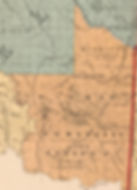
Several years ago, I took one of my usual road trips and found myself at a place called Indian City, USA. I vaguely remember my parents taking my sister and me on a trip from Paris, Texas to see "an authentic Indian village" back in the late 1970s, and since I believed it had been this attraction just south of Anadarko, Caddo County, Oklahoma, I re-made the journey around the turn of the 21st century (man, that sounds ANCIENT). I'm glad I did, because Indian City, USA is no more.
Indian City, USA was an outdoor museum, meant to portray the old lifeways of tribes whom the US government removed into Indian Territory after the Civil War (and others further west). Its location off OK State Highway 8, a straight-as-an-arrow road that follows a territorial survey line, was just above the Tonkawa River valley where the 1862 massacre of the Tonkawas, an annihilation attempt perpetrated by members of the Caddos, Wichitas, Shawnees, Apaches, Kiowas, and Comanches, took place.*
During its lifetime, Indian City, USA offered an educational look at how the Apaches, Comanches, Kiowas, Caddos, Cheyennes, Pueblos, and Wichitas lived and worked. The museum opened in 1955 just south of Anadarko to great fanfare; its dedication was attended by governor Raymond Gary, a big supporter of "good roads" and their role in tourism. While the town of Andarko is named after the Caddoan tribal villagers who had been forced out of Texas in the 1850s and is the home to the Caddo and Wichita tribal governments, they did not have as much input in the village as one would think. Instead, the non-native people of Caddo County sold stock in Indian City, USA to develop this roadside attraction and bring tourist revenue to the town. The museum employed native people, who wore their "native costumes" and engaged in history demonstrations. Their traditions were initially directed by a non-native professor of anthropology from the University of Oklahoma, who fashioned the displays according to research conducted at the University of California. In latter years, however, native people had more input in the displays and interpretation, including how to conduct demonstration war dances and pow-wows.
The location of Indian City, USA was even more complicated than its initial administration. Before the Civil War, this area had been part of the Chickasaw Nation, which was forced to cede the lands to the United States in 1866. The federal government then reserved those lands for the Kiowas, Comanches, and Apaches in anticipation of their defeat in the Red River Wars (a reservation for the Caddo/Wichita tribes never materialized). The Kiowas, however, weren't able to lay claim to the land for very long: the Dawes acts allowed white people to overrun the reservation by the turn of the 20th century.
Tourism dwindled substantially as road trips became less of an American pastime, and upkeep became too difficult as the area's population shifted towards the cities, causing Indian City, USA to close in 2004. But the good news is that in 2021, the Kiowa Tribe was able to reclaim the land (ca. 200 acres) again -- a victory for the abandoned lands doctrine -- and news releases stated that it would re-open Indian City, USA again.
So far, that hasn't happened. But here are some photographs I took of Indian City, USA in the year 2002 or 2003. Twenty years ago, give or take... geesh, maybe I should be put in a museum, too.
*In the aftermath of the Tonkawa Massacre of 1862, the tribe was nearly genocided. The tribal hostilities likely stemmed from the Tonkawas alliances with the Texans, who attempted genocides on the Caddos in the late 1850s.

















